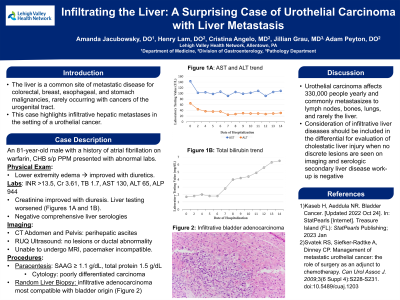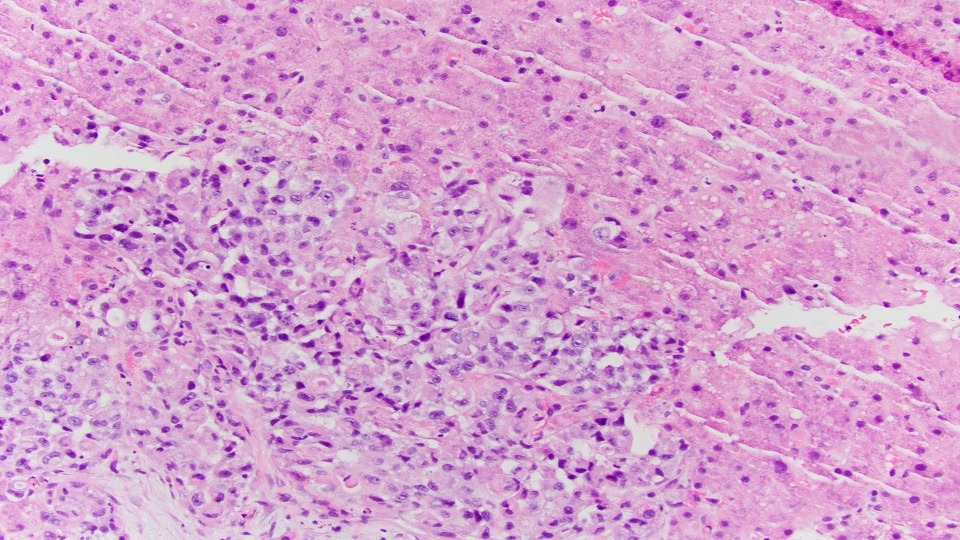Sunday Poster Session
Category: Liver
P1125 - Infiltrating the Liver: A Surprising Case of Urothelial Carcinoma With Liver Metastasis
Sunday, October 22, 2023
3:30 PM - 7:00 PM PT
Location: Exhibit Hall

Has Audio

Amanda Jacubowsky, DO, MSMEd
Lehigh Valley Health Network
Allentown, PA
Presenting Author(s)
Amanda Jacubowsky, DO, MSMEd1, Henry Lam, DO1, Cristina Angelo, MD1, Adam Peyton, DO2, Jillian Grau, MD1
1Lehigh Valley Health Network, Allentown, PA; 2Eastern Pennsylvania Gastrointestinal and Liver Specialists, Allentown, PA
Introduction: The liver serves as a common site of metastasis often manifesting as focal hepatic lesions on imaging. Common malignancies that spread to the liver include colorectal, breast, esophageal, and stomach. Hepatic metastases rarely occur with cancers of the urogenital tract. Here we present an atypical case of urothelial carcinoma with infiltrative hepatic metastases.
Case Description/Methods: An 81-year-old male with a history of atrial fibrillation and complete heart block status post permanent pacemaker presented with coagulopathy on outpatient laboratory testing. Labs noted an INR > 13.5, as well as an acute kidney injury (Cr 3.61 mg/dL) and liver dysfunction (TB 1.7 mg/dL, AST 130 U/L, ALT 65 U/L, ALP 944 U/L). On exam, the patient appeared volume overloaded with lower extremity edema. CT abdomen/pelvis showed an edematous liver with perihepatic ascites. Abdominal ultrasound was negative for hepatic lesions or ductal abnormalities and comprehensive liver serologies were unremarkable. Given these findings, the patient was thought to be volume-overloaded causing congestive hepatopathy and nephropathy. As such, he was started on intravenous diuresis with initial improvement in labs; however, his liver function started to worsen prompting further work-up. He was unable to undergo further imaging as his pacemaker was not MRI-compatible. For the ascites, the patient underwent paracentesis removing 100 cc of clear yellow fluid. Fluid analysis showed a SAAG ≥ 1.1 g/dL with a total protein of 1.5 g/dL consistent with portal hypertension of hepatic etiology. Ascitic fluid cytology revealed poorly differentiated carcinoma. Subsequent ultrasound-guided liver biopsy showed infiltrative adenocarcinoma most compatible with bladder origin. A goals of care discussion was held with the patient and family opting for hospice care.
Discussion: Urothelial carcinoma is a genitourinary tract cancer affecting over 330,000 people annually. Common sites of metastasis include lymph nodes, bones, and lungs. It involves the liver less frequently, as seen in only 19% of cases. Interestingly, our patient’s imaging was negative for focal hepatic lesions, suggesting a malignant infiltrative process causing cholestatic injury and liver dysfunction. As our case demonstrates, it is important to consider infiltrative diseases, including malignancies, in the differential for acute liver injury given the need for a multimodal approach to diagnosis and the potential for devastating outcomes.

Disclosures:
Amanda Jacubowsky, DO, MSMEd1, Henry Lam, DO1, Cristina Angelo, MD1, Adam Peyton, DO2, Jillian Grau, MD1. P1125 - Infiltrating the Liver: A Surprising Case of Urothelial Carcinoma With Liver Metastasis, ACG 2023 Annual Scientific Meeting Abstracts. Vancouver, BC, Canada: American College of Gastroenterology.
1Lehigh Valley Health Network, Allentown, PA; 2Eastern Pennsylvania Gastrointestinal and Liver Specialists, Allentown, PA
Introduction: The liver serves as a common site of metastasis often manifesting as focal hepatic lesions on imaging. Common malignancies that spread to the liver include colorectal, breast, esophageal, and stomach. Hepatic metastases rarely occur with cancers of the urogenital tract. Here we present an atypical case of urothelial carcinoma with infiltrative hepatic metastases.
Case Description/Methods: An 81-year-old male with a history of atrial fibrillation and complete heart block status post permanent pacemaker presented with coagulopathy on outpatient laboratory testing. Labs noted an INR > 13.5, as well as an acute kidney injury (Cr 3.61 mg/dL) and liver dysfunction (TB 1.7 mg/dL, AST 130 U/L, ALT 65 U/L, ALP 944 U/L). On exam, the patient appeared volume overloaded with lower extremity edema. CT abdomen/pelvis showed an edematous liver with perihepatic ascites. Abdominal ultrasound was negative for hepatic lesions or ductal abnormalities and comprehensive liver serologies were unremarkable. Given these findings, the patient was thought to be volume-overloaded causing congestive hepatopathy and nephropathy. As such, he was started on intravenous diuresis with initial improvement in labs; however, his liver function started to worsen prompting further work-up. He was unable to undergo further imaging as his pacemaker was not MRI-compatible. For the ascites, the patient underwent paracentesis removing 100 cc of clear yellow fluid. Fluid analysis showed a SAAG ≥ 1.1 g/dL with a total protein of 1.5 g/dL consistent with portal hypertension of hepatic etiology. Ascitic fluid cytology revealed poorly differentiated carcinoma. Subsequent ultrasound-guided liver biopsy showed infiltrative adenocarcinoma most compatible with bladder origin. A goals of care discussion was held with the patient and family opting for hospice care.
Discussion: Urothelial carcinoma is a genitourinary tract cancer affecting over 330,000 people annually. Common sites of metastasis include lymph nodes, bones, and lungs. It involves the liver less frequently, as seen in only 19% of cases. Interestingly, our patient’s imaging was negative for focal hepatic lesions, suggesting a malignant infiltrative process causing cholestatic injury and liver dysfunction. As our case demonstrates, it is important to consider infiltrative diseases, including malignancies, in the differential for acute liver injury given the need for a multimodal approach to diagnosis and the potential for devastating outcomes.

Figure: Pathology from liver biopsy showing infiltrative adenocarcinoma most compatible with bladder origin
Disclosures:
Amanda Jacubowsky indicated no relevant financial relationships.
Henry Lam indicated no relevant financial relationships.
Cristina Angelo indicated no relevant financial relationships.
Adam Peyton indicated no relevant financial relationships.
Jillian Grau indicated no relevant financial relationships.
Amanda Jacubowsky, DO, MSMEd1, Henry Lam, DO1, Cristina Angelo, MD1, Adam Peyton, DO2, Jillian Grau, MD1. P1125 - Infiltrating the Liver: A Surprising Case of Urothelial Carcinoma With Liver Metastasis, ACG 2023 Annual Scientific Meeting Abstracts. Vancouver, BC, Canada: American College of Gastroenterology.
